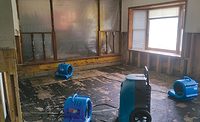Case Study Winner: Large Loss Water Damage Restoration
A Disaster Demonstrates the Value of Great Partners














This project really began a year before the flash flood came through the village of Penn Yan, New York. In June of 2013, Cleantec received a call for flooding remediation work on a building that was part of The Arc, a non-profit national organization that helps communities assist individuals with disabilities, hundreds of miles from the subject of this event. The work included mitigation and remediation for properties for The Arc chapter in Herkimer, New York. Their day habilitation center and 7 residence homes in their small town suffered a massive spring flooding event.
One year later, another chapter of the same non-profit organization servicing an even smaller village community suffered the same fate. On May 13, 2014, a flash flood swept through the village of Penn Yan, washing away major buildings and roadways. Built directly in the path of the flood waters rising from the stream was a 26,000 square-foot facility used for day habilitation and training for individuals with disabilities. Despite the heroic efforts of the director of facilities and his staff, sandbagging and pumping could not keep up with the rise of the waters and building was in a state of ruin.
A notice delivered over the local television station indicated that the village was experiencing devastating flash flooding. Cleantec, located 90 miles away, immediately dispatched responders to the area to support the residents with pump outs and board ups. Mark Lamphear, a senior restoration manager for Cleantec, immediately recalled the similar flooding restoration work he had done the year before, and realized the non-profit organization had a location here as well. Contact was made, the director made quick phone call to check us out a with their sister organization from a year before, and Cleantec was able to partner with the organization to support the mitigation efforts to save this building that was essential to their services.
As roads became passable, and the Cleantec team began to evaluate the damage, it became evident that this 100 year flood event had done massive damage to the building. A foot of contaminated water had entered the facility. Three days later, two feet entered with another flash flood. A state of emergency had been declared and four days passed before waters receded and remediation could finally begin.
The project was quickly understood to be an exercise in prioritization: where to begin? The water that entered the building was contaminated with agricultural runoff and was already four days old at the start, a CAT 3 cleanup for sure. A thick mud, 1 inch deep, had been evenly deposited throughout the building.
The facility was comprised of 65 offices, a commercial printing shop, a health clinic, community rooms, foodservice facilities, a community activity room, numerous restrooms and other areas all with saturated drywall, contaminated furnishings, and mud. It had been sitting for five days without power, the walls were wet, the building was full of office furnishings and personal items which were wet, carpet and laminate floors were full of water and mud, and it was mid-May, the seasonal heat and humidity was on the rise.
Could the building be saved?
A meeting with The Arc’s key people was called. Is the facility restorable? Should we mitigate and protect the building from further damage and contamination? Is the flooding over? Does the cleanup and repair exceed the value of complete demo and starting over? After discussion with the directors of the organization, the decision was made to attempt to save the building. The immediate action plan was to reduce the humidity inside the building, and get the mud and wet items out –fast. It was easier said than done, in this rural community that had suffered devastation from one end of town to the other. The basics of large loss catastrophic restoration management all became very real, very quickly; manpower, fuel, food and water, dumpsters and other basics that are taken for granted in suburban and city environments needed to be acquired in order to scale up to meet the challenge of drying and cleaning the building.
Calling in the troops
Within minutes of wrapping up the decision meeting, the phones were on fire as calls went out. A call was made to AMC Elite, our partner with the dehumidifier power to dry a building this large fast. (For the restoration guys who are already doing the dry out math, there was over 250,000 cubic feet of space, class 2). They immediately deployed a tractor trailer loaded with 4 5000 cfm dessicant dehus from Philadelphia. Cleantec mobilized from its base in Liverpool deploying 60 air movers, extractors, HEPA air scrubbers, wet vacs, all surface cleaning equipment and other tools to get the job going.
A call to ATSCO, our partners in Albany, New York, to bring in another 40 air movers was made and they delivered in less than 24 hours.
Richard Dickinson of Dickinson Environmental was called in by the client to perform a biological contamination assessment of the building. We knew another aspect of the challenge was going to be removing the microbial contamination brought in from the mud that had permeated the wall cavities and crawl space under the building. The microbiologist evaluated and established a protocol for a complete sanitization of the building from floor level to 2 feet high, this included cleaning and sanitizing each wall cavity as it was exposed, including wiping down exposed metal wall studs and cleaning out the metal base stud plates, which had filled with silt from the water. An estimated 75,000 square feet of drywall had to be removed.
The building contained an enormous amount of furnishings, most were not salvageable. Feher Waste Removal brought in two 30-yard dumpsters donated by the company to support the efforts. Feher provided daily removal of an additional eight dumpsters as the work progressed.
We would need to bring in an army of help to empty the building and get the saturated floor, drywall, and insulation materials out. Calls were made to the entire 150 person workforce employed by Cleantec, in addition to 4 IICRC certified restoration technicians and 2 IICRC certified restoration managers assigned. We also repurposed employees from our facility maintenance teams, our janitorial project crews, and our nightly housekeeping crews to support the effort. Local temp agencies were already stretched thin with the demand for labor throughout the area, but provided additional personnel as well.
From End to End
With the 18-wheel tractor trailer parked next to the door and the dehumidifiers hooked into the building, 100 air movers running in the building, the cleanup process began. Staff shoveled, wet vacuumed, used squeegees, mopped and hosed out the mud. Beginning on one end of the building, teams moved room to room, emptying the wet contents. A second team followed with tape measures and chalk line snapping a guideline exactly 24 and ½ inches from the floor across every wall. The third team used a variety of hand and power tools to cut the drywall on clean, straight lines. The final team disengaged the drywall from the studs, bagged and hauled it to the dumpsters. This process went on for several days as the dehus and fans were removing moisture from structural items and the concrete floor slab.
After the wet stuff was out, the work to sanitize began. Fiberlock Shockwave was used as the disinfectant; the entire building was cleaned 3 times, including each metal wall stud. The Hygienist sampled surfaces and cultured the results to determine the presence of E Coli, fecal coliforms, and Enterococcus bacteria. Finally, the building was clean and dry.
Facing the costs
The damage exceeded the limits of the clients insurance. FEMA funds were unclear. The small non-profit organization was financially strapped to stay in operation through the crisis. The Governor and state legislators were working to get funds to the residents of the community whose homes had been destroyed, but any help for businesses was thought to be unlikely. It was apparent this disaster could close this organization down permanently and end the important service they had provided this community for many years. On the other side, Cleantec had committed vast amounts of financial resources and a companywide focus from ownership to administrators, to operations managers to get the project scaled up and going, it was a combination of desire to help a community, willpower to see it through, and faith the disaster wouldn’t drown either Cleantec or the customer that kept us moving forward.
As the costs for the mitigation were totaled up, Cleantec was aware of the situation, and wanted to proceed slowly with collecting payment for the work. As rumors of state and federal relief funds came and went, Cleantec worked with the organization to take partial payments as available throughout the remainder of the year, providing the organization with the ability to direct operating funds to continue to service clients.
Rebuilding
Another year later, while researching some specific information for writing this article, I contacted the client with a question, I have included the email here, to show that after the crisis has passed and the water damage mitigation company has packed up and left, for the owners of the building, the work has just begun.
Looking for a reprint of this article?
From high-res PDFs to custom plaques, order your copy today!














